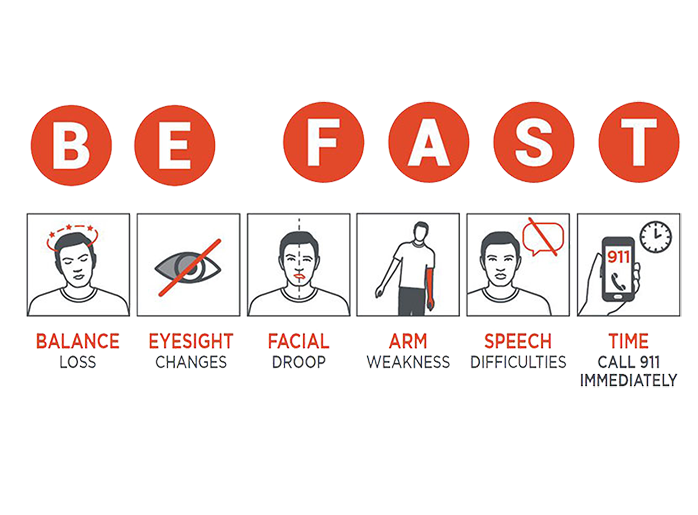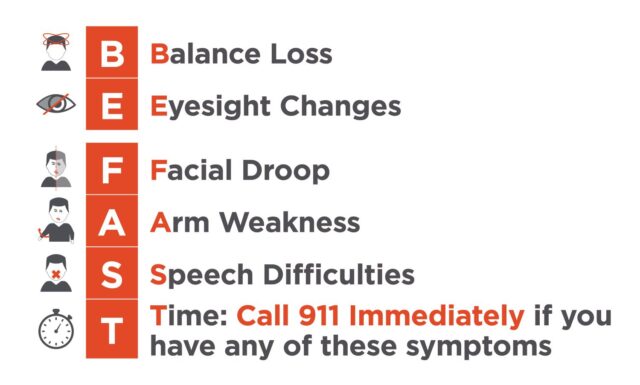Stroke
In Stroke, Every Minute Counts
Stroke is the sixth leading cause of death in Minnesota, and the leading cause of long-term disability. It’s also a condition whose outcome relies on the speed of care.
Call 911 at the first sign of a stroke. Minutes count. Time saves brain.

Condition Overview
What is a Stroke?
A stroke occurs when a blood vessel is blocked or bursts, cutting off blood flow to the brain. When blood flow to the brain stops, cells in that part of the brain are starved of oxygen and are damaged or die. Because your brain controls how you move, think and behave, a stroke may affect any of these functions.
Basic signs of a stroke are one-sided facial droop, arm numbness or weakness, balance issues, sudden vision changes or any speech trouble.
Other names for a stroke you may have heard include brain attack, transient ischemic attack (TIA) and cerebral vascular accident (CVA).
For in-depth information on stroke, risk factors, recovery and prevention, view our stroke education guide.
What is a Transient Ischemic Attack?
Transient ischemic attack (TIA) is a warning sign of a possible stroke and is often called a “mini-stroke.” A TIA is caused by brief stoppage of blood flow to the brain. Symptoms are the same as a stroke but appear for a shorter period of time (from a minute to 24 hours) and then goes away. This can be falsely reassuring. A TIA is basically a stroke with one important difference: blood flow resumes before any serious brain damage occurs.
About one-third of people who have a stroke have a preceding TIA. In a significant proportion of people, stroke develops within 48 hours of having a TIA. A TIA is a warning of a stroke and should be a cause for concern. All symptoms should be reported to your doctor as soon as possible.
Stroke prevention is crucial for those who had transient ischemic attack (TIA or mini strokes). Lifestyle changes, surgery, medicine or all three are important to preventing further strokes. Early interventions and treatment are critical.
Call 911 at the first sign of a TIA or stroke.
Stroke is an Emergency
 Warning Signs of TIA and Stroke
Warning Signs of TIA and Stroke
We use the acronym BEFAST: balance, eyes, face, arms, speech and time. Time is a crucial factor.
With a stroke, someone may not have pain and therefore be slower to come to the hospital. But every minute they’re losing brain cells, so the longer they wait, the more pronounced the damage. And there are certain methods of treatment that can only be done within a few hours of the onset of symptoms.
Other possible symptoms include:
- One-sided numbness, or paralysis of face, arm or leg
- Sudden confusion or trouble understanding speech
- Blurred vision or loss of vision
- Dizziness or loss of balance
- Sudden, severe headache
- Sudden nausea and vomiting – different from a viral illness because of how fast it begins (minutes or hours versus several days)
- Brief loss of consciousness or period of decreased consciousness (fainting, confusion, convulsions or coma)
Even symptoms lasting a few minutes should be taken seriously. If you have any of the above symptoms, dial 911. Every minute counts.
Common Types of Strokes and Causes
Clot (Thrombotic Stroke)
Narrowing of the artery
An artery might become blocked due to a blood clot that forms inside the artery. The main cause is hardening of the arteries (atherosclerosis).
How an artery becomes blocked:
- Atherosclerosis begins with fat deposits in the wall of the artery, a process that may begin early in life.
- Over time, the vessel wall thickens and the inside of the artery narrows. Also, the blood vessel wall becomes rough and irregular. This causes blood cells to stick to the rough surfaces and form clots.
- The clots may become large enough to totally block the blood vessel.
Traveling Clot (Embolic Stroke)
The clot has traveled from another part of the body
There are two common causes of a traveling clot:
- A piece of clot breaks loose and is carried through the blood to the brain where it blocks a blood vessel. This clot may come from many areas such as the heart or carotid artery.
- Or if the heart beats irregularly (atrial fibrillation), or if the heart muscle is weak, clots may form inside the heart. Pieces of this clot may break off and travel to the brain.
Bleed (Hemorrhagic Stroke)
The bleed is from a weak spot in the artery
Hemorrhage occurs when a blood vessel breaks, leaking blood into the brain (intracerebral) or into the area around the brain (subarachnoid). There are two common causes of a hemorrhagic stroke:
- High blood pressure: Weakens the blood vessel walls.
- Aneurysm: A weak spot in an artery wall that becomes thin and stretched and may rupture.
Risk Factors
Risk Factors You Cannot Control
- Age: The chances of having a stroke increase with age. Two-thirds of all strokes happen to people over the age of 65.
- Gender: Greater in males than females with the exception 35-44 years old and greater than 85 years old.
- Race: African Americans and Hispanics have a higher risk for a stroke than some other racial groups.
- Family history: Those with a family history of heart disease, high blood pressure or stroke are at a higher risk.
- Personal history of diabetes: The reason people with diabetes are at risk may be due to poor circulation. In addition, brain damage may be more severe if blood sugar is high at the time of a stroke.
Risk Factors You Can Control
Certain medical conditions can put you at a higher risk for stroke. It is important to control and manage these risk factors to the best of your ability.
- High blood pressure: High blood pressure is the most common risk for stroke.
- High cholesterol: Too much cholesterol in your bloodstream can build up over time and block your arteries.
- Diabetes: If you are diabetic, it is important to control blood sugar. High blood sugar levels can damage blood vessels.
- Heart and blood conditions: Common heart problems such as heart disease, valve defects, irregular heart beat (such as Atrial Fibrillation) and an enlarged heart can cause blood clots.
- Sleep apnea: If you had a diagnosis of sleep apnea prior to your stroke, we recommend a follow up appointment with your sleep specialist.
- Misuse of prescription drugs: Take your drug at the same time each day, and never stop taking a drug without first talking with your doctor.
- Alcohol use: Before you choose to drink alcohol, even in moderation, talk to your doctor and pharmacist.
- Smoking: Smoking has been linked to the build-up of fatty substances in the carotid artery, the main artery in the neck that supplies blood to the brain.
- Being overweight: Losing weight will reduce the strain on your heart, and often, will improve your blood pressure.
North Memorial Health Stroke Education Guides
Our Stroke Program at North – Robbinsdale Hospital and North – Maple Grove Hospital is committed to providing patients and caregivers with the resources they need to get the best possible care and live full and rewarding lives.
North – Robbinsdale Hospital
The Comprehensive Stroke Center at North – Robbinsdale Hospital is equipped to treat the most complex stroke cases. We offer a Balance Center, an Intensive Cognitive Program and a range of support groups, helping both patients and their families recover from the effects of stroke.
North – Robbinsdale Hospital Stroke Guide
North – Maple Grove Hospital
North – Maple Grove Hospital’s Stroke Program is a stroke-ready site, meaning we can evaluate, stabilize, and provide emergency treatment to patients with stroke symptoms. Designated by the MN Department of Health and staffed by the same emergency medicine doctors as North – Robbinsdale Hospital, North – Maple Grove Hospital is able to quickly and efficiently begin the assessment and treatment. If a transfer is needed to North Memorial Health Comprehensive Stroke Center, all information is easily shared within the system.
North – Maple Grove Hospital Stroke Guide
To learn more, visit our Stroke Program webpage or call 763-581-3650.
